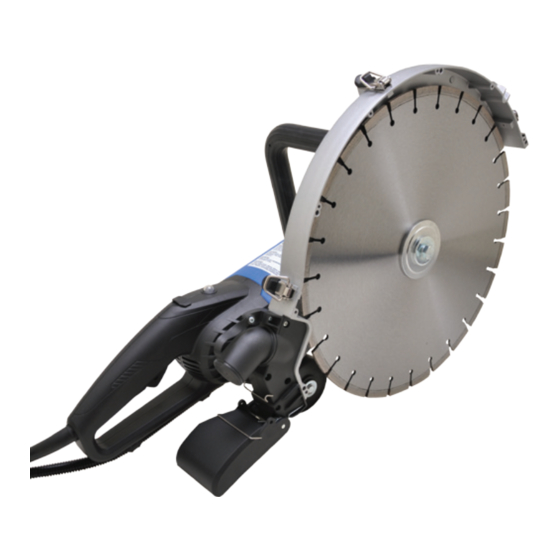DIAQUIP QHS-400 Manual del usuario - Página 13
Navegue en línea o descargue pdf Manual del usuario para Sierra DIAQUIP QHS-400. DIAQUIP QHS-400 18 páginas. Electric handsaw

OPERATION
Proper Support for the Workpiece
Support the workpiece on in such a way
that the kerf will not pinch down on
the blade.
Secure the workpiece so that it will not
roll, slip away or move due to vibration
while cutting
The cutting sequence is important when
making cutouts. Always make the last cut
in a way that avoids the blade being pinched. Thus, make the bottom horizontal cut first,
then the sides and finally make the top horizontal cut last.
Make note of the weight of the workpiece and the direction which it will fall when it is cut
through.
Whenever there is a situation where severing the workpiece will cause a hazardous
situation, leave a tab of material intact and finish off the operation with a chisel or the like.
Cutting Technique
Holding the machine with both hands to resist the start up torque, press the release button
and then squeeze the trigger switch.
Allow the machine to reach full speed before contacting the workpiece.
Adjust the water flow as needed by turning the water feed valve.
Then gently begin the cut with the rear portion of the blade until the kerf is established.
Make the first cut in the forward direction (so that you can see the line of cut). Then make
following cuts in the backward direction.
Do not try to cut too much depth in one pass. Never exceed about 50mm (2") per pass. It
is better to cut in multiple passes to minimize the cutting contact area of the blade and
keep the blade spinning fast.
/24
OPERATION
Cutting Technique (continued)
Release Button
Stopping
Trigger Switch
Release the trigger to stop the machine. After the trigger is released, the blade will continue
spinning for a time.
WARNING: Do not set the machine down until the blade has stopped turning.
WWW.DIAQUIP.CO.UK
WWW.DIAQUIP.CO.UK
1
It's a good idea to first cut a shallow guiding groove in the forward direction before
proceeding to make the main cut in the backward direction. If any correction is needed.
Lift the blade and cut slightly ahead and then back into the existing kerf. Take care to avoid
the blade being pinched.
In round workpieces, the best technique is to use a slow, uniform back and forth motion
while cutting with the bottom quadrant of the blade.
Do not allow the machine to bog down. Limit your feed pressure to keep the blade spinning
at high speed.
Never side load the blade in the kerf.
If the workpiece is very heavy and may cause a hazard when it is cut through, do not cut
all the way through the material. Leave some tabs of material intact and then finish the cut
with a chisel or similar tool.
Concrete cutting is very stressful for the motor: After the cut is finished, it is a good practice
to run the machine at no load for a short time to lower the motor temperature before
stopping.
1. Forwards
2. Backwards
2
/25
